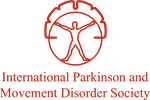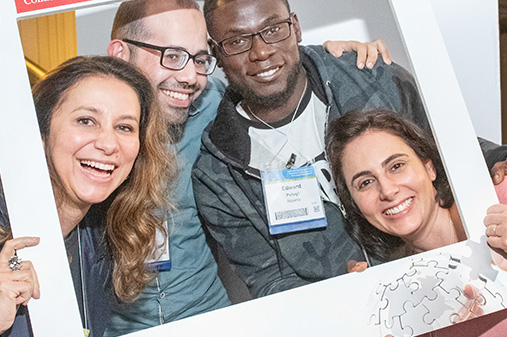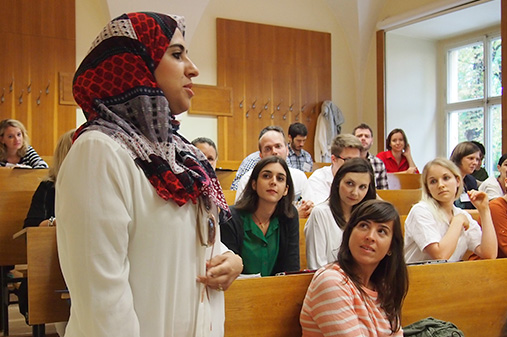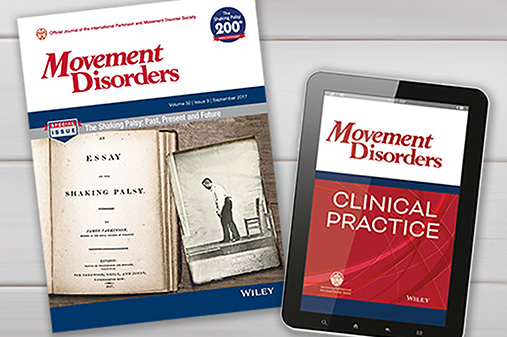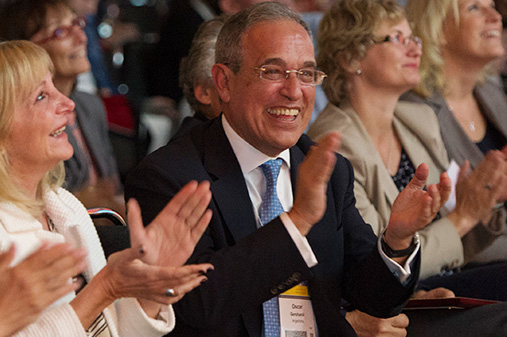Tremor Series: What's in store? The future of tremor research
[00:00:05] Dr. Alfonso Fasano: Hello everyone and welcome to the MDS Podcast, the official podcast on the International Parkinson and Movement Disorder Society. I'm Alfonso Fasano, professor of neurology at the University of Toronto in Canada. I'm the guest editor for this new special series on tremor. Today I'm interviewing two great guests, Dr. Aesef Shaikh and Dr. Ming-Kai Pan. We're going to discuss with you a very complex topic, and I'm sure that all the listeners would be very interested to hear their take on this particular episode that is entitled, What's in Store? The Future of Tremor Research. So let's start with Dr. Aesef Shaikh, I can call Aesef and I'm going to ask Aesef where you're working, so your affiliation, and what you're working on right now. Please say Aesef.
View complete transcript
[00:00:49] Dr. Aesef Shaikh: Thank you Alfonso and hello Ming-Kai, it's so good to see you both my name is Aesef Shaikh. I am a professor of neurology at Penni and Stephen Weinberg chair in brain health [00:01:00] at the University Hospitals in Cleveland and Case Western Reserve University. My laboratory is located at Cleveland VA Medical Center and also National VA Parkinson Consortium Center there.
The focus of my lab is rather multidisciplinary and our major interest now in the lab is to bring in various movement disorders such as tremor, dystonia, and Parkinson, and view them with the lens of an ocular motor or vestibular standpoint. So we are studying visual spatial navigation in Parkinson, in dystonia, in tremor disorders.
How deep brain stimulation changes, visual spatial navigation abilities in these complex Movement Disorders. We are also very interested in eye movements, phenomenologies, and eye movement phenotypes in some of these disorders. How we can use ocular motility, especially in Parkinson's, for example, as a marker for the disease.[00:02:00]
And we are also very interested in studying single unit physiology and local field potentials in tremor and dystonia in particular. And studying how different disease processes changes it, different disease phenomenology is different for the cellular characteristics and also the local field potential.
So it's more diverse and multiple different projects going on in the lab.
[00:02:23] Dr. Alfonso Fasano: Thank you Aesef. And now let's hear from Ming-Kai.
[00:02:28] Dr. Ming-Kai Pan: Hi . I'm from national Taiwan University. I'm working as a associate professor of pharmacology in the College of Medicine. And I'm also affiliated with the National Taiwan University Hospital working as a neurologist and also working in the department of Medical Research. So I'm working like a crossover between basic neuroscience and movement disorders. So I'm doing this new field called neurodynamics, where you record neurons in animal models and doing electrophysiology in patients, [00:03:00] intraoperative or do non invasive EEG. My major focus is motor controls, especially the cerebellar perspective for precision motor controls.
And also as well tremors how the tremor frequencies being calculated and how tremor amplitude has been modulated, using this circulatory perspective and how the neural firings about this. Pretty much in clinically I'm working with the new technology we incorporate is the cerebellum, EEG.
So doing cerebellum perspective to record their EEGs and manipulate it using TACS or TMS to manipulate the neurons and see what happens coming back and forth with animal models as well.
[00:03:41] Dr. Alfonso Fasano: Very good. As the listeners can tell you guys are working from different perspective on different concepts and also different object of research, more human versus more animal. In putting together this episode, I thought that we could really learn a great deal from you both.
And now the question is actually focusing on tremor, [00:04:00] obviously, what do you think is going on right now? So where is the field going in terms of Tremor research? We can start from Ming-Kai and then we'll hear from Aesef.
[00:04:09] Dr. Ming-Kai Pan: Yeah. And that's the next question that tremor is such a complicated disease that we still very diverse etiology. From my perspective and our colleagues in neurodynamics, we're trying to figure out two important things, because any tremor can be defined by two things mathematically. One is tremor frequency, and the other is tremor amplitude.
So we're trying to figure it out that how the neuron computes the frequency and the amplitudes in the circuit, because no matter how diverse the background pathogenesis will be the amplitude and the frequency things seem to converge across different etiology and pathogenesis. So this is something currently not only happens in my lab, but other labs in for simple, like my Dr. Hollis lab and my mentor and [00:05:00] other are colleagues in Canada that also see the same things that we're trying to understand something that is instead of the one approach to precision medicine, we are working on another that, that is the converge mechanism in tremor.
[00:05:14] Dr. Alfonso Fasano: Thank you. And now let's hear from Aesef.
[00:05:18] Dr. Aesef Shaikh: Yeah I very much appreciate what Ming-Kai said. I had a additional few things to add. And I come from vestibular and oculomotor field as a background. Before I started my life as a movement disorder, I was looking at nystagmus and various eye oscillations. I can imagine, I can view tremor not just from the frequency and amplitude standpoint.
Of course, it's a very important feature to study. But another very important aspect of any oscillation is the shape. And that is something that my lab is very interested is in shape analysis of various oscillations. And it allows us to characterize tremor versus certain other movement [00:06:00] disorders, which are also rhythmic, which are also repetitive, but they may not be a tremor, but they may appear like a tremor.
So shape analysis, I think is very important from not just the phenomenological standpoint, but it also tells us a bit about the etiology. And it may have a potential for a better classification system when we use the wearable sensors in humans to classify various forms of tremor versus the tremor mimics.
And along that lines, the major thrust, I think, which is pretty hot in the field is a better way of classifying different tremor disorders. Is this dystonia with the tremor? Is tremor associated with dystonia a bit different than what we call a regular essential tremor? Or Parkinsonian tremor, how we can use the shapes regularity patterns, rhythmicity of the oscillations in addition to frequency and amplitude for their classification.
[00:07:00] Along that lines, one can completely envision utilizing frequency, amplitude, shape, regularity, these as individual parameters of the tremor. And create a machine learning algorithm, a clustering algorithm, and deploying that into the cloud, and then assisting the clinicians who may have a wearable sensor in the clinic to classify the patients more objectively.
So this is, I think, the field is headed in that direction when it comes down to the phenomenology. The other very interesting and exciting work, I think, in tremor is its relationship with the local field potentials and its relationship with a single unit activity into the brain and utilizing that signature to close the loop.
That's another exciting thing, I think, in the field which is going on and there is a lot of room for growth in that direction. So these are the two additional things I think.
[00:07:59] Dr. Alfonso Fasano: Yeah, thank [00:08:00] you. I was sure you were going to discuss what you just said and putting together this interview. That's actually the reason why I included both of you because you both have of an interest in tremor. As I mentioned before, you tackle it from different angle, but as we heard from Ming-Kai.
He's mentioning the issue of encoding tremor and frequency. And I know, I knew already that Aesef was going to say well, that's not enough. You need to look into the shape because you might miss the coexistence of other problems. That is the issue of dystonic tremor or dystonian tremor. That's a big issue, but probably most of Ming-Kai's attention at the moment is towards the understanding of what essential tremor is. Versus Aesef is looking more into what dystonic tremor is, if we want to use this term. While there are so many other tremors, we probably, we won't need to cover Parkinson's tremor. In this regard, we should acknowledge Rick Helmich's work and his switch dimmer theory. But let's stick to this tremor that I just mentioned, essential tremor and dystonian tremor.
And I want to ask, [00:09:00] starting at this point from Aesef, what's your take? What's the relationship between what we call essential tremor and when we have something that looks like essential tremor in a patient with dystonia? So Aesef, what do you think?
[00:09:12] Dr. Aesef Shaikh: Yeah, it's a very interesting question. It's a complex question. It sounds very simple question, but I think it's very complex question and I don't think that we know. We don't have enough mechanistic understanding whether when dystonia and tremor when they co occur is that a unique disease entity where one etiology is causing both or there are two separate etiologies.
One is causing dystonia, one is causing tremor. They just happen to be together. From what we understand from some of the data that we had collected with single units and local field potentials That data points out to the dystonia and tremor being a independent etiologies. But they [00:10:00] happen to be together in the same patient perhaps they may have some common roots, but it is causing two different pathophysiological process.
But again this is just one study and There is a lot more needs to be done to understand the more rigorous relationship between dystonia and tremor, but for sure they happen together all the times we see that and that is clear need to dissect them further.
[00:10:28] Dr. Ming-Kai Pan: That's one of the most difficult questions nowadays that people are trying to understand. And I totally agree with Aesef that, for example, that this tonic tremor and the essential tremor are different in shape. And mathematically that means that there are differences in their frequency harmonics.
And what happens in current neurodynamic approach from animal models to patients is trying to understand how the circuitry dynamics. So the expert like Alfonso can use deep brain stimulation to treat [00:11:00] this pathophysiology. That is probably better than anybody else in the world.
For dystonic tremor versus essential tremor. One of the discovery from the animal perspective is how these neurons fire and how they assembled as a population is very different. So as it probably also has some data with this. So we start to see things not categorize them. So you have to be dystonia. You have to be essential tremor. It's probably happens that some of them actually can overlap just because they're different brain regions.
They assemble new neuronal activities in a different way. So you could have dystonic like tremor and essential tremor like sinusoidal tremor at the same time. So that is probably why that in clinically they are so complicated and the differentiation is very difficult because they are probably truly overlapped with each other.
[00:11:53] Dr. Alfonso Fasano: Thank you. Well, certainly we all agree that this is an area of active research and more needs to be done. Now, I want to [00:12:00] twist this question a bit more and talk about another entity that is cerebellar tremor. And I'm doing that because obviously Ming-Kai has worked a lot in the physiology of the cerebellum, that to some extent also tells us about ataxia more in general.
So the question is. We assume the essential tremor is mainly a cerebellar problem. But then the question is, what's the relationship between cerebellar tremor, essential tremor? Can we say it's the same thing? Can we say they're different and why they are? Why some people start with something that we will call essential tremor, but over the years, it becomes more and more of what's being called outflow tremor, like a real dysmetria with cerebellar tremor.
So what's, in other words, the relationship between cerebellar tremor and essential tremor? Ming-Kai, you are the first.
[00:12:47] Dr. Ming-Kai Pan: Oh, Thanks. This is like the cutting edge questions in the field that the short answer is that we don't completely know, but current evidence is that cerebellum is doing two things. One of the main [00:13:00] thing is that it's actually calculating the necessary rhythm. For example, essential tremor is a disease that is too much rhythm, that has unstoppable rhythm.
But the other upcoming evidence is that when you lost the necessary rhythm for physiological movement, then you actually get ataxia. So It's just like the flip of the coins in the different sides. But there's another thing that controlled cerebellar tremors is that cerebellars are also doing one of the things is to calculate precisions.
And if it is undershooting or overshooting, they will do the corrections. And this back and forth corrections of this decelerating and accelerating movement create another type of tremor. And they are both, could potentially both generate from the cerebellum. We can be more conservative because the tremor could come from other places.
But for the cerebellum, these two types of mechanisms co exist. For physiologically, you actually need those mechanisms to do a [00:14:00] precise movement. But if any of this has some problems, then you can have either cerebellar tremor or more essential tremor like sinusoidal tremor. So there are actually different mechanisms.
[00:14:11] Dr. Alfonso Fasano: Interesting take, thank you.
Aesef. What do you think?
[00:14:14] Dr. Aesef Shaikh: Yeah. I am again viewing this with slightly different perspective, maybe a little out of box and bringing in the analogy of oculopalatal tremor, right? We know that as a tremor, which Or an oscillation which originates in the inferior olive and then it changes through the life of the patient.
Coming back to the question that Alfonso originally asked that some tremor starts off as one type and one type of phenomenology and as time passes it grows into either predominantly cerebellar or a bit different and how that works. And the way I view that is tremor is a network disorder, right? So it's for example, the type of phenomenology that [00:15:00] Ming-Kai and other colleagues have recorded in rodent models of tremor, similar type of phenomenology in single units, we find them into the basal ganglia neurons in humans when we record from them.
So there is clearly a continuum between different regions and in oculopalatal tremor models, what we have simulated and what we have been observing is that one oscillation starts in one region, and then that passes on to the cerebellum, and then it creates an adaptive or maladaptive, process, which then changes the oscillation property completely.
Because now we have another oscillator, which is a result of a maladaptive process. Now we have two oscillators, over a period of time, and now the tremor characteristic is entirely different. So it all depends that how the primary oscillator creates maladaptation or adaptation in a different part of the brain and [00:16:00] whether that is good enough or strong enough to override the initial oscillator or the initial oscillator keeps going on.
And that whole adaptive process is highly dependent from subject to subject, how they are wired inherently. And I think that it could be one of the reasons, again, this is very out of box, and there is much more work needs to be done to establish that theory. But this could potentially explain why some people go in one direction and the other people go in a different direction.
[00:16:31] Dr. Alfonso Fasano: Very interesting take, and you're certainly emphasizing not just the circuit where tremor originates, but also the way the brain deals with it and the compensation and many things that the brain is putting in place to avoid that the system is too unstable. Which is actually linked to my last question to you which has to do again with the cerebellum.
The cerebellum is being certainly the organ with the highest number of studies when trying to understand particularly essential tremor where it comes from. A lot has been [00:17:00] done also looking at the role of the thalamic DBS and the role of the DBS when the electrodes are close to the fibers from the cerebellum reach the thalamus. But then the question is what if we got it all wrong? What if the cerebellum is simply relaying and amplifying a pathological signal coming from somewhere else? So if you want to bet on a different structure in the brain, Or even outside the brain for example, in the spinal cord, where would you look?
What organs or circuit you'd be interested in exploring? And we can start from Aesef.
[00:17:34] Dr. Aesef Shaikh: One clear target that comes to mind is inferior olive. Now you can argue that this could be very much part of the cerebellum, but it is part of the function of cerebellum and in some tremors which are known to come from inferior olive, these patients may have normal cerebellum. So that would be of course one structure that I would look at.
Of course the other structures I would look at is thalamus and the basal ganglia because they are also [00:18:00] connected to the cerebellum and if cerebellum is completely fine, but if the oscillator is coming from one of the other regions such as basal ganglia or thalamus, you could still see some of the flavor of cerebellum because of the connectivity.
And spinal cord of course, it's a very interesting concept and it's a emerging area and the other thing that i would look into would be a feedback proprioceptive feedback, right? Is there something wrong with the proprioceptive feedback, the way they are handled? And that can also create Issues for example multiple sclerosis a lot of ms related tremor can be because of the delay in the feedback at least let's take pedular eye oscillations, right?
They are like tremor. The concept is similar and we can tell that it could be from the delay in the feedback loop. So similar feedback loop delay from the proprioceptor can also cause tremor. Again, [00:19:00] you can simulate that in the mathematical model. So that would be another area.
[00:19:04] Dr. Alfonso Fasano: Thank you, Aesef. Ming-Kai, what's your take?
[00:19:08] Dr. Ming-Kai Pan: I could not agree more with Aesef that there are definitely other places than the cerebellum could generate tremor, and it's definitely a circuitry disease, so we have to look at the circuitry very closely. And one of the examples is that if you have peripheral nerve problems, for example, it's conductive problems, then you'll have this neurogenic tremor just because their sensory feedback is slowing.
And then, and basal ganglia is doing, definitely doing some works in other tremor genesis, particularly the parkinsonian tremor there are evidence that direct recording with the Basal Ganglia in pallidum and even animal model that simply manipulating the STN or the internal globus pallidus internus, that could generate Parkinsonian like rest tremors.
So that definitely [00:20:00] already proved that. Other places can also generate a tremor like movements or basically just tremor. So we have to take this very seriously. And the one good things that with the, this neurodynamic and DBS research is that we start to think about things in a network perspective.
For example, in the modeling that you probably, if you do molecule biology you're probably not able to find any bad hydrodynamic receptors that has expression issues. But in tremor, it's definitely working many of the tremor patients and it works in the circuitry level. It's not that some of the neurons that are not expressing enough beta hydrogenergic receptors.
It's just that it changed how the neuron oscillates throughout the circuitry level. So I'm totally agree with Aesef. And It's not enough to emphasize more that the deep brain stimulation research and circuitry research has something to do with finding a new target of tremor research and [00:21:00] tremor therapies that are not able to find by molecular biology approaches.
[00:21:04] Dr. Alfonso Fasano: Thank you. Thank you. Very insightful answers from both of you. So this is the end of this interview, although I would like to speak with you for hours, probably. So thanks again for accepting this to be part of this podcast. I want to thank the listeners too. This was What's in Store, The Future of Tremor Research.
I'm Alfonso Fasano from Toronto. And today with us, we had Dr. Aesef Shaikh and Dr. Ming-Kai Pan. Thank you guys.
[00:21:29] Dr. Aesef Shaikh: Thank you.
[00:21:30] Dr. Ming-Kai Pan: Thank you. [00:22:00]

Aasef Shaikh, MD PhD
Case Western Reserve University and Cleveland VA Medical Center
Cleveland, USA
Ming-Kai Pan, MD PhD
Department of Medical Research
National Taiwan University Hospital
Taipei City, Taiwan
